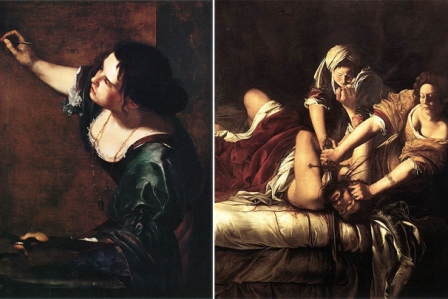
WTI Magazine #57 2015 April, 3
Author : Giovanni Verde Translation by:
Artemisia Gentileschi was born in Rome on July 8, 1593. Since she is a child, she shows to have an extraordinary talent for painting, also pushed by the stimulating Roman environment made by several artists friends of his father Orazio, also a painter. The style of his father was referring explicitly to that of Caravaggio, thus also Artemisia follows his footsteps until getting to personally know the great Lombard artist.
The influence of Caravaggio is mitigated by the equally strong influence of her father: the apprenticeship in Orazio's studio represents for Artemisia the only way to practice her art, being prohibited for a female painter to attend art schools. As a matter of fact, at that time a woman could not even work, but she had to live just out of her family status; women's work was not officially recognized, so it was done illegally.
The first artwork attributed to the seventeen years old Artemisia, albeit aided by her father, determined to improve and promote her early artistic talent, is "Susanna e i vecchioni" (Susanna and the Elders) of 1610. It is impossible not to associate the pressure exerted by the two characters to Susanna in the painting to the complex relationship of Artemisia with hers father and with Agostino Tassi, the painter who in May 1611 will rape her. The process that follows ends for Tassi with a mild sentence, and is extensively documented: the rawness of Artemisia's reporting is shocking, and it will have a great influence to understand in a feminist way the figure of Artemisia Gentileschi, which will be rediscovered only in the second half of the twentieth century.
Artemisia becomes a symbol of international feminism. The establishing of such a strong image is helped by her character of being a woman firmly committed to pursuing her independence and her artistic statement against the many difficulties and prejudices encountered in her troubled life. For a woman in the early seventeenth century, to paint - as Artemisia did - represented a choice neither common nor easy.
The painting which depicts "Giuditta che decapita Oloferne" (Judith slaying Holofernes) in 1613, stored at the National Museum of Capodimonte near Naples, is impressing for the violence of the scene it depicts, and it has been psychologically and psychoanalytically interpreted as a desire for revenge against the violence she suffered.
After the conclusion of the process, in the November of 1612 Orazio combines for Artemisia a marriage with Pierantonio Stiattesi, a modest Florentine artist, which will be instrumental for Artemisia, raped, deceived and denigrated by Tassi, to come back to a social status of sufficient "integrity". Shortly after the marriage the couple moves to Florence, where they have four children: but only the daughter Prudenzia lives long enough to follow the mother back to Rome and then to Naples. Leaving Rome is almost obligatory: the painter has lost the favor and the appreciation from the other artists, overshadowed by the scandal.
The story of Artemisia Gentileschi is then revalued in the following centuries. In recent times, many associations and clubs have been entitled to the great Italian painter, symbol of a kind of woman who, in years of great difficulties, has been able to make her own history with determination and courage.



